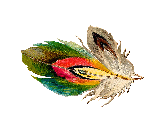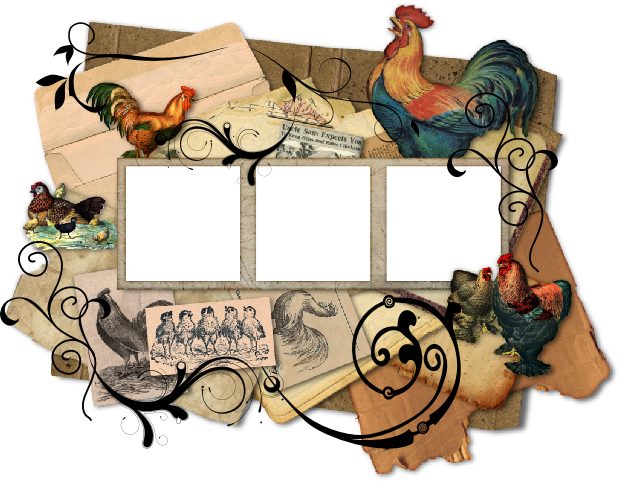
Notice the picture above-
But also notice that in this picture, Jack is NOT the sun in the center of their
chicken solar system at this moment-
This picture is a perfect example of how central the Head Roo and Head Hen are to
the flock-
Introducing New Birds To Your Flock
Meet & Greets
The Satellite Of Love

Velvet Sparrow
Meet & Greets
What’s a ‘Meet & Greet’ and why should chickens have one?
‘Meet & Greets’ are what I call introducing new birds to your existing flock, whether they are adults or youngster chicks. Meet & Greets help incorporate the flock MUCH more smoothly than just throwing new chickens in and hoping they’ll float, will save wear and tear (literally) on your chickens by avoiding fights, and help save your sanity.
But no, sadly, no little ‘Hello my name is’ badges. Unless that’s your thing…in which case, hey, go ahead.
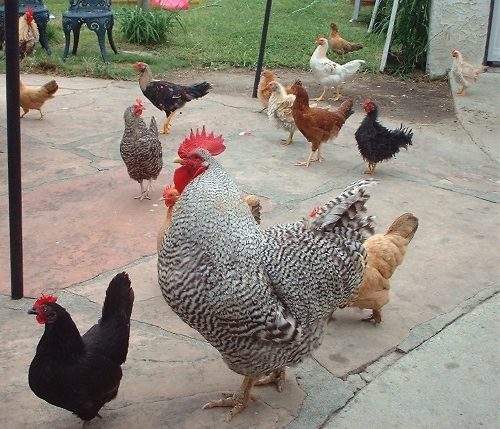 >
>
Jack’s Henhouse
Meet & Greets With Adult Birds
Whenever I need to bring in a new adult chicken to the existing flock, I follow the
same procedure that I do with blending a new batch of youngsters in. I always hold
several of what I call "Meet & Greets". I've found that this is a great way to introduce
newcomers to a flock. It cuts down on the violence you get otherwise when you just
toss 'em all together. There is still the establishment of the pecking order, but
that's a given anyway. I directly supervise the introduction, and anyone who gets
out of line gets figuratively 'pecked' by ME, since I am the Head Hen/Roo. When you
first bring a new chicken home, they will be off balance, a little scared, shy and
confused. Now is the time to use this to your advantage and tame the little stinker
down! It's also a wise idea to trim your new chicken's wings (not outdoors in case
it gets away, do it inside) so that it is less likely to fly over the fence or up
into a tree. Remember, it's going to be scared and fresh grist for the 'Pecking Order'
mill. If it is chased and trying to get away, the last thing you need is a chicken
that doesn't know you or where it lives yet-
Once the wings are clipped, allow the new bird to roam around a bit in your kitchen
(where the inevitable poop won't be too difficult to clean up) or bathroom while
you croon softly to it and feed it little bits of cheese, lunchmeat, diced grapes,
raw corn, etc. The bathroom is great because there isn't much room for the bird to
get away from you, so they are forced to deal with you and tolerate you being nearby.
Sit down on the floor so you aren't towering over it-
There are two schools of thought on how to proceed next. Some people advocate waiting until dark and then slipping the new bird in amongst the flock as they are asleep and roosting, so that when they awaken they can be more accepting of the new bird. This may be your only option if your birds are in a small coop and/or run and the newcomer doesn't have much room to get away from any bullies.
I've personally had better luck with the following: With adult birds, after you have thoroughly petted and fed your new friend, pick it up and take it into the yard during the day. Hold it tucked under your arm and call your flock. When they come running over, they will look with amazement and disgust at you for thinking you needed another bird. Your Head Hen and birds uppermost in the pecking order may make make jealous noises, stare at the new bird and/or stand sideways to it in a threat posture, maybe even fluffing up. The new bird may note this and, not wanting to get it's butt kicked; struggle to get away, so watch out and keep your grip on it. Continue to hold and pet the new bird as you talk to the flock and walk around the yard a bit, showing the new bird around. Walk in and out of the coop. View the nest boxes. Point out the food and water dishes. Give 'em the two dollar tour.
When everyone is ready, go ahead and put the new bird down slowly and stand next
to it. Some of your birds will show undue aggression-
The pictures below show a typical Meet & Greet with a new adult hen.
Lily, the new white Sultan hen on the right, meeting the flock. Note how close we stand. The other hens are alert, heads and tails up.
Boots, the bantam partridge Cochin on the right and Lily each grow an attitude and start throwing threat postures at each other. New chickens will either act submissive and duck and run, or flare up. Note Lily’s reddened face and flared tail, she’d already decided she wasn’t gonna take any guff from Boots.
Uh oh, henfight! It wasn't serious, and we moved right in to break things up. But here you can see how even hens can raise their hackles!
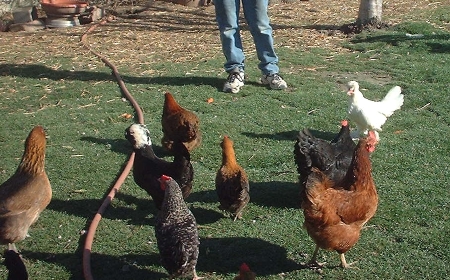 >
>
Jack’s Henhouse
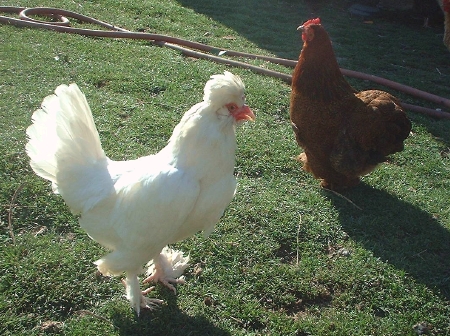 >
>
Jack’s Henhouse
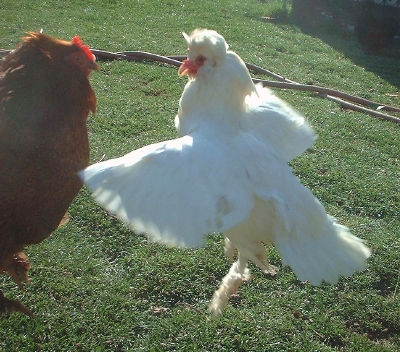 >
>
Jack’s Henhouse
YOU are the Head Roo, remember, and what you say, GOES. Be gentle in shooing away
any bullies however, your little feather children love you and they are jealous because
they value your attention, after all-
As for teaching the new bird where to eat, drink and roost for the night, a good
way to do this is to step into the coop a couple of times during the day with little
treats and give it to them in there (be careful not to cause a stampede for goodies
where the new one could get hurt), or place the food and water in the coop so that
they have to enter it to eat, and will associate the coop with pleasant things. I
just leave my coop door propped open during the day, with food and water kept inside
and the chickens coming and going as they please. My chicks never had a problem with
instinctively following the flock and going to the coop to roost, but then in my
yard the coop is the best place to roost so they prefer it. Of course, there's no
harm in showing them where to go, and I'd certainly be out there the first couple
of evenings watching at dusk to see if they go into the coop on their own or are
bullied if they try to-
Meet & Greets With Youngsters Or Chicks
With a bunch of young chicks, the procedure is the same, except that you need to break up the Meet & Greets into a daily 20 minute session over a few days to a week. If you have a small pen or cage that you can set on the ground with the chicks inside, great. That gives your flock a chance to stare at them in dismay and at you in disgust and get used to the whole idea of newbies. Also, young chicks are innocent of what a threat posture from an adult bird looks like and will just stand there and let an adult peck them, or will stupidly walk right up to your Head Hen and stare her in the face (major disrespect!). So the pen gives the chicks protection. I use the same procedure even if the chicks have been raised by a mama hen, because mama can't be everywhere at once, and while she's chasing off one aggressor, two more can swoop in and harm the chicks. Plus it’s very stressful for mama to try and ward off all the hens. You still need to pull up a chair and hang out, praising your flock and petting them. They are going to be pretty peeved at you.
I’ve never had a rooster attack chicks, in my experience they tend to behave just like hens towards newcomers–provided it isn’t another rooster! If you are trying to introduce a new rooster into a flock that already HAS a roo, they WILL fight, possibly pretty badly and to the point that it really upsets the hens. Roos that have been raised together from youngsters won’t have that kind of problem, instead they work it out as they go, with one eventually attaining Head Roo status.
I usually start Meet & Greets when chicks are 6 weeks of age, because at 8 weeks they are going out into the flock for good. Before that age there is a chance they may get trampled or seriously hurt, but at 6 weeks they are big enough and have gained a tiny bit of awareness of the social order by interacting with each other.
Youngsters are going to have to put up and deal with a certain amount of bullying from some of the flock members, that’s just how it is. You can’t be there 24/7. Everyone will adjust.
 >
>
Jack’s Henhouse
Meet & Greets With Roosters
Fortunately, adult roosters being introduced to a flock of all hens don't usually
need the safety pen or the full protection of a Meet & Greet. You need to allow the
new roo to assert himself somewhat, it's important to his status within the flock.
Just be nearby to end any real fighting. Very young roos will have a tougher time
than a mature one, the hens will not appreciate the young whippersnapper at first.
Roos take time to mature, calm down and not be such jerks. New roos can often suffer
at the hands (and beak, claws and wings) of your Head Hen. Don't be surprised if
she attacks or picks a fight with a new rooster, she's just letting him know who
is Head Hen. Usually roos will just duck and accept this posturing with good graces-
If you are trying to insert a second rooster into a flock that already has a roo,
you are in for a struggle, and usually not a successful one. It all depends on the
personality of both roos and how committed you are to enforcing your Head Roo status
and breaking up any posturing that looks like it's getting too serious. I've had
better luck raising two roos together from chicks (one will usually naturally end
up Head Roo, without too much fighting) or introducing the second roo as a youngster,
who learns his place just like any other youngster does. If you have two roos who
get into serious battles all the time, which cause injury and draw blood, you need
to rehome one of them-
Jack, my Head Roo, with newly-

Enjoying the chickens? Has my site helped you?
Want to buy the chickens some goodies?
Click the button!



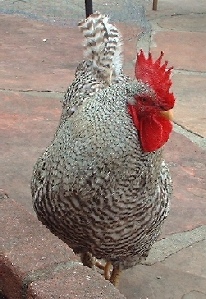 >
>



